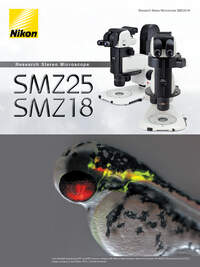- en Change Region
- Global Site
- Home
- Products & Services
- Stereo Microscopes
- SMZ25 / SMZ18
Customer Interview
Customer Interview Sample preparation utilizing the SMZ18 is the key to microscopic videography
YONE PRODUCTION CO., LTD.
Kanako Morioka (Director, Research Department)
Preparing high-quality samples is the first step towards capturing beautiful images. Making samples for microscopy is a detailed, sometimes hours-long process that requires patience, skill, and ingenuity. Yone Production, a company that produces life science videos, employs the SMZ18 stereo microscope for this purpose. Here, Kanako Morioka of the Research Department at Yone Production, who oversees sample preparation, shares her experience of using the SMZ18.
— Please tell us what work the Research Department at Yone Production handles.
Yone Production produces life science videos using microscopes. In the Research Department, we create specimen samples suitable for microscopic shooting. When detailed work is required, we use the SMZ18 stereo microscope. If the samples are not well made, even with a high-performance microscope, clear images cannot be captured, so we are very aware that we are responsible for the most important step in video production.
— What kind of samples do you create using the SMZ18?
While assembling a chamber used for observing living cells, we utilize the SMZ18 when work needs to be done under a stereomicroscope. At our company, we use a rather old-fashioned chamber called a Rose chamber1 when observing living cells or tissues for long hours. The SMZ18 is useful for cutting out cell sheets and attaching them to the chamber's cover glass, as well as for checking the finish of the sample.
We also employ the SMZ18 to prepare sliced specimens from fresh samples such as sections of plant materials. The collected materials are sliced under a stereomicroscope using a single-edged razor blade and floated in water in a petri dish. We also select sliced specimens suitable for observation under a stereomicroscope.
Rose chamber
The Rose chamber was developed by G. Rose in the 1950s and has since been modified in various ways to suit different applications. The general construction consists of a rubber spacer sandwiched between two cover glasses and two metal plates, all secured with four screws. A cell sheet is attached to one cover glass, and the space between the cover glasses is filled with culture medium. Long-time observation of living cells is possible by inserting a syringe needle into the spacer to replace the culture medium. Yone Production researchers have observed slow-growing cells such as bone cells using this chamber. The chamber in the photo above is a dummy example prepared for image purposes and is not filled with culture medium.
Preparation of sliced specimens for stereomicroscope observation.
A piece of lichen* or other plant material sandwiched between two pieces of polystyrene foam is sliced entirely through, including the polystyrene foam, with a razor. The key to preparing a good sample is to “slice as many as possible and then select the best.” This image is a clip from the video showing plant material being sliced, taken with the SMZ18 stereomicroscope.
*Symbionts of fungi and algae
Photographs of the sliced specimens prepared under a stereomicroscope (SMZ18) and photographed with an inverted microscope (ECLIPSE Ti2-E).
[Left] Horizontal section of a stem of Cladonia vulcani Savicz (lichen). It is composed mainly of mycelium, with algae symbiotically present in the algal layer slightly inside the surface layer (upper cortex).
3 × 3 tiled images taken with a 40X objective on the ECLIPSE Ti2-E microscope.
[Right] Vertical section of thallus of Marchantia polymorpha (liverwort) A variety of structures can be seen, such as air pores and rhizoids. In the Research Department, Marchantia polymorpha is often used as practice material for specimen preparation.
Taken with the ECLIPSE Ti2-E, 10X objective lens magnification.
— Please give us your impressions of using the SMZ18.
When I joined the company, quite old stereomicroscopes were being used in our department. These were later replaced with the SMZ18 when it was time for an upgrade. Compared to the old models, the SMZ18 has a wider field of view and is brighter even at high magnification, so our work efficiency has increased. The zoom function is useful for creating a rough sample at a low magnification and then switching to a higher magnification to check the details. In addition, the SMZ18 can be used without any problems for tasks that require stereoscopic vision, such as extracting an embryo from a fertilized chicken egg.
What's more, the function to change the angle of the eyepiece (ergonomic tube) is very helpful. When the task takes a long time or when multiple people take turns observing, adjusting the direction of the lens tube greatly reduces the burden on the viewer’s neck and back. Furthermore, the SMZ18 is also very useful for education within the research department, as it is possible to explain while showing the actual work by projecting it on a monitor.
Before joining Yone Production, I studied biotechnology, but I did not have much experience with microscopes. I learned the basics of microscopy after joining the company, and now I enjoy observing samples with a microscope. When the SMZ18 was introduced to our department, I was so surprised by the wide field of view and brightness that I felt the urge to try taking videos of microorganisms in the soil and water around me. I actually recorded some and uploaded them to our company's social networking site. An easy-to-see, easy-to-use microscope improves not only work efficiency but also boosts motivation. I look forward to seeing the interesting samples I can prepare using the SMZ18.
1. Rose G. Tex Rep Biol Med. 1954; 12(4): 1074-1083.
This article is intended to introduce our business and is not an advertisement.
In addition, this page contains interviews with customers about the product, which are not intended to guarantee the efficacy, effectiveness, or performance of the product, nor to indicate that the customer endorses, recommends, provides instructions on, or selects the product.


